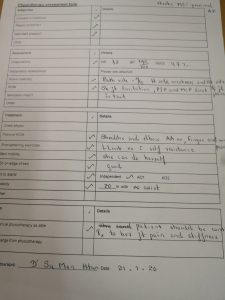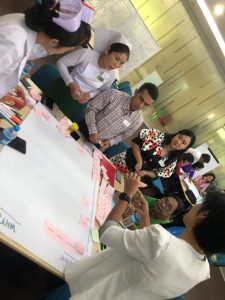27TH JANUARY 2020
By Caroline Kelly
As the end of the road (to Mandalay) grows closer, Sam and myself have been focusing our attention on how we are going to leave our projects. This involves tying up loose ends, handing projects over to our local counterparts, and finishing preparations for the all team February visit.
In regard to note writing, we started following up the rotational staff working in areas with approval to write notes. They were finding our simplified note writing forms easy to use and with discussion in our PDT meeting, we all left feeling hopeful that these forms would allow for a time-efficient note writing process. All we need now is for this to be approved across all areas of practice – something we will follow up on only after returning to the UK.

The three of us repeated the teaching about secretion management this week, but this time with a combination of neuro ICU nurses, general ICU nurses and physios. It was a quieter cohort therefore we aren’t certain what level of skill of understanding the participants had, but we are hopeful that if nothing else, the message of MDT working was relayed.

Robyn started up her next set of interviews which continued through the weekend, making it a very long working week for her!
At the end of the week, Sam and I met with the two newly formed “static” ICU physios to establish how they envisage their service to look. This was a very useful meeting for laying the framework on which they can now build their service around. We hope that this might be the start of a form of mentorship structure within the physiotherapy department. Fingers crossed!
By Robyn Winters
In a surprising turn of events, it has suddenly become Sam and Caroline’s last week here. We decided to try to get in all of our favorite things one last time, including going to a body combat class at the gym.
Truth be told, this was actually Sam’s first and last time, but I’m sure he wishes he’d gotten to go more often during his time here. Keep working on that upper cut!
We were put in touch with a couple of fellows from a previous cohort from the Improving Gobal Health (IGH) group, and met up with them for dinner one night to discuss a workshop they’d be putting on at the hospital. Both geriatricians from England, they wanted to do some research to explore how to improve healthcare for the older population of Yangon. We were all too happy to jump on board with their project, and Monday morning found us facilitating discussion with delegates from across health disciplines.
We utilized methods based on the paper “Engineering Better Care”, from Cambridge University Hospital & CGHP’s own Dr Tom Bashford, and the discussion that followed was fantastic. The two fellows made all sorts of creative supplies available – colored markers and pencils, large flip charts, even Play-doh – so that delegates could more freely express themselves in ways that could cross-cut language barriers. In one exercise, we talked about the needs of older persons in Yangon, and how we would prioritize such needs.

The group I was with decided to create a fictional character named U Ba to help them develop the narrative of a typical older person in their community. With drawings and notes, they challenged each other to think about different aspects of care, and some of the results were really fascinating. Coming from the NHS, I hadn’t really considered how much the financial status of a person or their family would dictate the quality of their healthcare. While the government does subsidise some treatments or medications In Myanmar, it is widely recognised that private funds are critical for managing the needs of this population.

Here, one of the social workers explains to nurses, doctors, and care providers how the elderly in a care home she works with enjoy using Facebook to stay connected. She says they love going into the garden and taking photos with the flowers for their “daily post”! Others then contributed their own experiences with elderly people either in their care or in their own family. It was fantastic to be a part of the conversation, and to laugh over how some things are the same in any culture.
It was also interesting to hear from some of the healthcare professionals that I wouldn’t otherwise meet. This collection of drawings below features a diagram (in the center) drawn by one of the delegates who is a traditional healer. She was depicting one of the therapies she uses for treating neuropathic pain.

It was a wonderful experience, and I hope the others got as much from it as I did. I’m hoping to use some of the same techniques in my own interviews back at the hospital. Moral of the story -sometimes you get a lot more from just helping people tell their stories rather than trying to fit them into your checklist boxes to gather data.
Return to blogs

